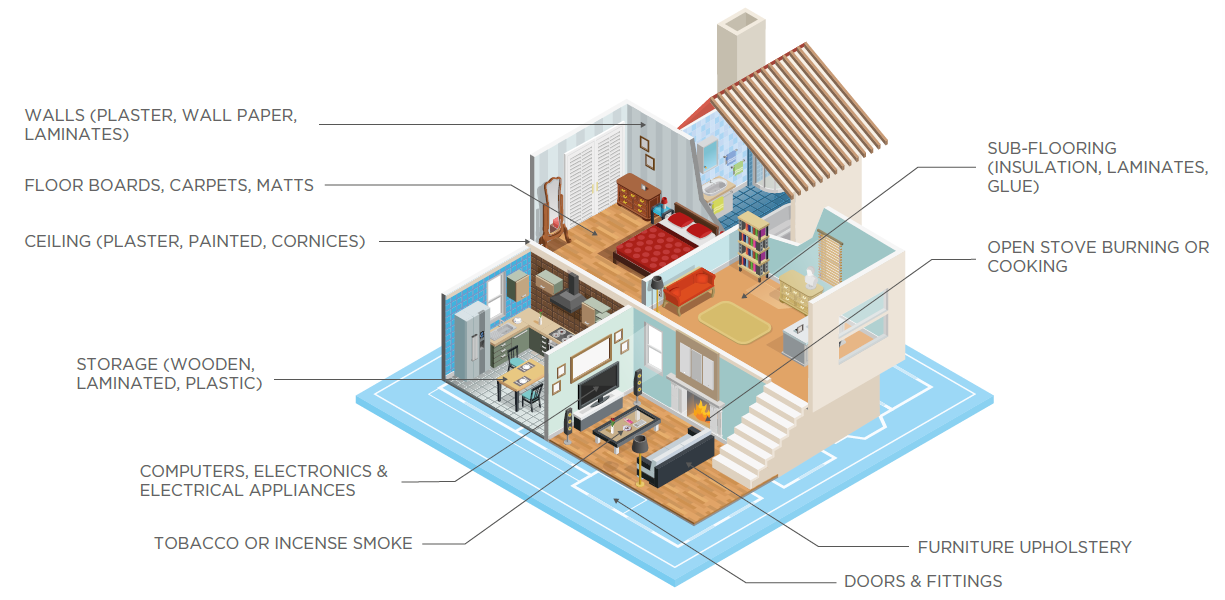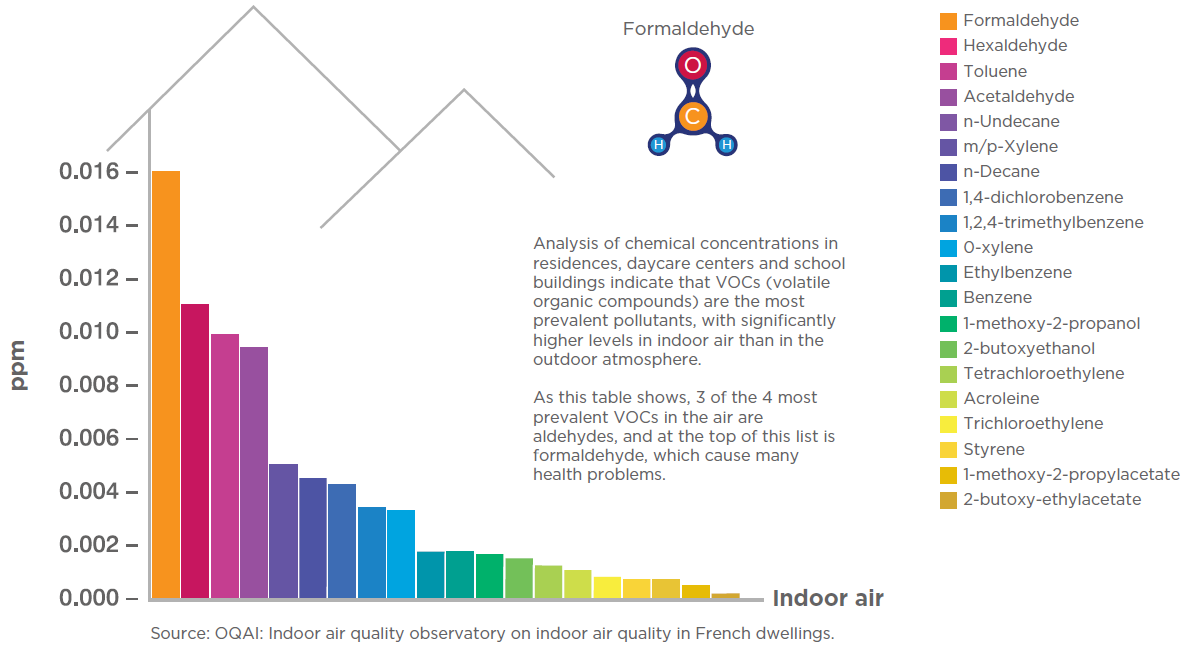| |
| Gyproc® Activ’ air |
| |
| Clearing the air to reduce volatile organic compounds such as formaldehyde |
| |
Formaldehyde is a colourless, flammable, strong-smelling chemical that is used in building materials and to produce many household products. It is used in pressed-wood products, such as particleboard, plywood, and fibreboard; glues and adhesives; permanent-press fabric; paper product coatings; and certain insulation materials. In addition, formaldehyde is commonly used as an industrial fungicide, germicide, and disinfectant, and as a preservative in mortuaries and medical laboratories. Formaldehyde also occurs naturally in the environment. It is produced in small amounts by most living organisms as part of normal metabolic processes.
Sources of formaldehyde gas are common throughout most homes and can be steadily off-gased from lit cigarettes, storage cabinets made of particle board, subflooring, carpeting, wallboard, electronics, furniture, ceiling and flooring materials, door casings, insulation, household chemical products, and open stoves or heaters – just to name a few man-made sources inside. The most common way to be exposed to formaldehyde is by breathing air containing formaldehyde. This usually occurs in indoor environments where the gas has been released from formaldehyde-containing products. Exposure to liquid formalin may be through the skin or by ingestion. |
| |
| How Activ’ air cleans the air |
| |
| Gyproc® Activ’ air captures formaldehyde filled gases in the air and converts formaldehyde and other aldehydes into inert compounds. |
| Activ’ air then traps formaldehyde within the board for up to 50 years, based on tests and analysis. |
| |
 |
| |
COMMON SOURCES OF INDOOR AIR POLLUTANT EXPOSURE
|
| |
 |
| |
| CHARACTERISTICS |
| |
| A high performance gypsum board consisting of an aerated gypsum core with special additive encased and firmly bonded to strong paper liners. |
| |
| RECOMMENDED APPLICATION |
| |
| Suitable for use as wall and ceiling systems in all conditions with or without direct decoration. Can be integrated into product use in classic, moisture-resistant, robust,fire, and acoustical purposes. |
| |
| PRODUCT FORMAT |
 |
| Activ’ air can be applied in any type of Gyproc® plasterboard |
| |
 |
| |
| FIRE RESISTANCE |
| |
| When integrated with appropriate range of product, capable to provide up to 4 hours fire resistance performance in accordance with BS 476: Part 22. (Consult Gyproc® Technical Department for more details) |
| |
| REACTION TO FIRE |
| |
- Non-combustible according to BS 476: Part 4
- Low fire propagation according to BS 476: Part 6
- Class 1 surface spread of flame according to BS 476: Part 7
- Classified as Class 0 material according to building regulation
- Low flame spread index < 25 according to ASTM E84
|
| |
| MANUFACTURING SPECIFICATIONS |
| |
| In compliance with ASTM C1396 and BS EN 520 |
| |
| AESTHETIC PROPERTIES |
| |
- Highly flexible in creating the highest standards of design
- Easily decorated with paint, cornices, etc.
- Crack-free
- Seamless and smooth finishing
|
| |
| HANDLING AND WORKABILITY |
| |
- Lightweight
- Quick and easy installation
|
| |
| THERMAL INSULATION |
| |
| Recommended design thermal conductivity, k-value= 0.18 W/m.k |
| |
| REACTION TO MOISTURE |
| |
- Applicable to moisture-resistant Activ’Air boards
- The gypsum compound consists of water repellent additive that reduce moisture absorption of the boards
- Water absorption < 5% w/w (according to BS 1230: Part 1 and ASTM C473)
|
| |
| CONTRIBUTION TO HEALTH AND ENVIRONMENTAL |
| |
- Made from 100% natural gypsum
- Recyclable material, hence environmentally friendly and certified with Green Product Certification Scheme
- Does not produce toxic fumes or hazardous substances that are harmful to health
- Product is manufactured in a facility that is certified to standards of ISO 14001 and ISO 9002.
|
| |
How can formaldehyde affect my health?
|
| |
| Breathing air containing low levels of formaldehyde can cause burning and watering eyes. As levels increase, it can cause burning of the nose and throat, coughing, and difficulty in breathing. Some people may be more sensitive to formaldehyde and have effects at levels lower than expected. Strong mixtures of formaldehyde gas or liquid can cause irritation or a rash if they contact the skin. When swallowed, formaldehyde can cause severe pain, vomiting, and diarrhea. Formaldehyde that enters the blood stream can produce effects similar to drinking too much alcohol. |
| |
| ALLERGIC REACTIONS |
| |
- People have suffered dermatitis after wearing clothing that contained high levels of formaldehyde.
- After exposure to formaldehyde in solution form or in resins used in clothing and textiles, people can become sensitive to formaldehyde and develop on-going allergies.
- People who have become sensitized to formaldehyde may suffer:
- Asthma
- Contact dermatitis
|
| |
| SKIN IRRITATIONS |
| |
- Skin rashes can result from exposure to formaldehyde. Symptoms of temporary exposure to formaldehyde vapour will usually disappear quickly, with no lasting effects, once exposure stops.
- Breathing formaldehyde vapour can result in imitation of nerves in the eyes and nose. This may cause:
- A sore throat
- Teary eyes
- Blocked sinuses
- Runny nose
- Sneezing
- Burning stinging or itching sensations
|
| |
Adverse effects on central nervous system in occupational settings where people have significant daily exposure to formaldehyde they may suffer:
- Headaches
- Depression
- Mood changes
- Insomnia
- Irritability
- Attention deficit
- Impairment of dexterity, memory, and equilibrium
|
| |
.png) |
| |
How is formaldehyde associated with manufactured housing?
|
| |
| Products that contain formaldehyde compounds can release formaldehyde gas into the air. These compounds are found in our everyday use products which is commonly manufactured with materials such as plywood, particle board, and other pressed wood products. The amount of formaldehyde released is greatest when the product is new. Formaldehyde is also released more readily at warm temperatures and high humidity. |
| |
| HOW DO I KNOW IF I HAVE FORMALDEHYDE IN MY HOME? |
| |
| Formaldehyde can be detected through the sense of smell even at very low levels due to its strong odour. |
| |
| HOW CAN I REDUCE MY EXPOSURE TO FORMALDEHYDE? |
| |
- Increase air flow in the a�ected area by opening windows and doors. This lowers the level of formaldehyde by increasing the amount of outdoor air. Usually, the levels decrease and odours are gone within a few days.
- Replace formaldehyde containing materials with non-toxic, formaldehyde-free, green building materials such as Gyproc® Activ’ air boards.
|
| |
| Apart from new products that contains formaldehyde, daily activities such as cooking, smoking, cleaning or painting also contributes to formaldehyde being released into the air. |
| |
| VOC CONCENTRATIONS IN THE AIR |
| |
 |
| |
Effectiveness of Activ’ air on formaldehyde reduction
|
| |
The EUROFINS laboratory in Denmark tested the air-purifying effect of Activ’ air against consistently high emissions of pollutants into the surrounding ambient air and thereby the effectiveness of the construction material in reducing pollutant levels (performance).
The figure shows that Activ’ air performs significantly better than conventional gypsum fibre boards with no Activ’ air complex and even permanently reduces the concentration of pollutants emitted on an ongoing basis by more than 70%. |
| |
| HOW LONG DOES THE Activ’ air PURIFYING EFFECT LAST? |
| |
| Research and development departments have calculated in simulations that the material is effective for 50 years. |
| |
 |
| |